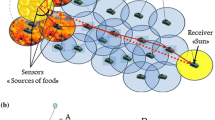Abstract
Geographic routing in wireless sensor networks requires sources nodes to be aware of the location information of sinks to send their data. To provide the sink location service, quorum-based schemes have been proposed, which exploit crossing points between a quorum of a sink location announcement (SLA) message from a sink and a quorum of a sink location query (SLQ) message from a source node. For guaranteeing at least one crossing point in irregular sensor networks with void areas or irregular boundaries, the previous schemes however collect and flood the network boundary information or forward a SLA and SLQ message along the whole network boundary. In this paper, we design a novel quorum-based sink location service scheme that exploits circle and line quorums, which does not require the network boundary information and send a SLA and SLQ message along the whole network boundary. In the proposed scheme, a source node sends a SLQ message to the network center and sends another SLQ message to an edge node in the network boundary, thus generating a SLQ line quorum. On the other hand, a sink node sends a SLA message along a circle path whose center is the network center, thus forming a SLQ circle quorum. By this way, it is guaranteed that the SLQ and SLA quorums have at least one crossing point in irregular sensor networks. Both numerical analysis and extensive simulation results verify that the proposed scheme outperforms the existing schemes in terms of the delivery distance, the delivery hop count, and the energy consumption for providing sink location service.



















Similar content being viewed by others
References
Karp, B., & Kung. H. T. (2000). GPSR: Greedy perimeter stateless routing for wireless networks. In Proceedings of the 6th annual international conference on mobile computing and networking (pp. 243–254). Boston: ACM Press.
Hofmann-Wellenhof, B., Lichtenegger, H., & Collins, J. (1997). Global positioning system: Theory and practice (4th ed). Berlin: Springer.
Han, S., Lee, S., Lee, S., Park, J., & Park, S. (2010). Node distribution-based localization for large-scale wireless sensor networks. Springer Wireless Networks, 16(5), 1389–1406.
Kannan, A., Fidan, B., & Mao, G. (2011). Use of flip ambiguity probabilities in robust sensor network localization. Springer Wireless Networks, 17(5), 1157–1171.
Chen, Q., Kanhere, S., & Hassan, M. (2013). Adaptive position update for geographic routing in mobile ad hoc networks. IEEE Transactions on Mobile Computing, 12(3), 489–501.
He, T., Stankovic, J. A., Lu, C., & Abdelzaher, T. F. (2005). A spatiotemporal communication protocol for wireless sensor networks. IEEE Transactions on Parallel and Distributed Systems, 16(10), 995–1006.
Tan, G., & Kermarrec, A. (2012). Greedy geographic routing in large-scale sensor networks: A minimum network decomposition approach. IEEE/ACM Transactions on Networking, 20(3), 864–877.
Zeng, K., Yang, J., & Lou, W. (2012). On energy efficiency of geographic opportunistic routing in lossy multihop wireless networks. Springer Wireless Networks, 18(8), 967–983.
Intanagonwiwat, C., Govindan, R., & Estrin, D. (2000). Directed diffusion: A scalable and robust communication paradigm for sensor networks. In Proceedings of the 6th annual international conference on mobile computing and networking (pp. 56–67). Boston: ACM Press.
Ye, F., Luo, H., Cheng, J., Lu, S., & Zhang, L. (2002). TTDD: A two-tier data dissemination model for large-scale wireless sensor networks. In Proceedings of ACM/IEEE MOBICOM(pp. 148–159).
Yu, F., Choi, Y., Park, S., Lee, E., Jin, M., & Kim, S. (2008). Sink location service for geographic routing in wireless sensor networks. In Proceedings of the IEEE WCNC.
Park, H., Kim, T., Lee, J., Jin, M., & Kim, S. (2009). Sink location service via inner rectangular in wireless sensor networks. In Proceedings of the IEEE AINA.
Stojmenovic, I., Liu, D., & Jia, X. (2008). A scalable quorum-based location service in ad hoc and sensor networks. International Journal on Communication Networks and Distributed Systems, 1(1), 71–94.
Chen, D., & Varshney, P. (2007). A survey of void handling techniques for geographic routing in wireless networks. IEEE Communication Surveys and Tutorials, 50–67.
Xiang, L., Luo, J., & Vasilakow, A. (2011). Compressed data aggregation for energy efficient wireless sensor networks. In Proceedings of the IEEE SECON.
Aziz, S., & Pham, D. (2013). Energy efficient image transmission in wireless multimedia sensor networks. IEEE Communications Letters, 17(6), 1084–1087.
Liu, Y., Xiong, N., Zhao, Y., Vasilakos, A., Gao, J., & Jia, Y. (2010). Multi-layer clustering routing algorithm for wireless vehicular sensor networks. IET Communications, 4(7), 810–816.
Guo, W., Xiong, N., Vasilakos, A., Chen, G., & Cheng, H. (2011). Multi-source temporal data aggregation in wireless sensor networks. Springer Wireless Personal Communications, 56(3), 359–370.
Fekete, S. P., Kroeller, A., Pfisterer, D., Fischer, S., & Buschmann, C. (2004). Neighborhood-based topology recognition in sensor networks. In Algorithmic aspects of wireless sensor networks: First international workshop (ALGOSENSOR) (pp. 123–136).
Bondy, J. A., & Murty, U. S. R. (1976). Graph Theory with Applications. North-Holland: Elsevier.
Niculescu, D., & Nath, B. (2003). DV based positioning in ad hoc networks. Telecommunication Systems, 22(1–4), 267–280.
Kim, H. S., Abdelzaher, T. F., & Kwon, W. H. (2003). Minimum-energy asynchronous dissemination to mobile sinks in wireless sensor networks. In Proceedings of the 1st ACM international conference on Embedded networked sensor systems (pp. 193–204).
Lee, E., Park, S., Yu, F., & Kim, S.-H. (2010). Data gathering mechanism with local sink in geographic routing for wireless sensor networks. IEEE Transactions on Consumer Electronics, 56(3), 1433–1441.
Chen, D., Deng, J., & Varshney, P. (2007). Selection of a forwarding area for contention-based geographic forwarding in wireless multi-hop networks. IEEE Transactions on Vehicular Technology, 56(5), 3111–3122.
Scalable Network Technologies, Qualnet, [online] available: http://www.scalable-networks.com.
Polastre, J., Szewczyk, R., & Culler, D. (2005). Telos: Enabling ultra-low power wireless research. In Proceedings of the IEEE IPSN.
Author information
Authors and Affiliations
Corresponding author
Rights and permissions
About this article
Cite this article
Lee, E., Yu, F., Park, S. et al. Design and analysis of novel quorum-based sink location service scheme in wireless sensor networks. Wireless Netw 20, 493–509 (2014). https://doi.org/10.1007/s11276-013-0613-x
Published:
Issue Date:
DOI: https://doi.org/10.1007/s11276-013-0613-x




